6 Best Grass Types for Southern California
BY LAUREN BRYANT | MAY 10TH, 2023 | CALIFORNIA, LAWN CAREThere’s nothing like relaxing on a fresh green lawn on a sunny day. But what kind of grass do you need to create your dream lawn?
Any SoCal turf has to handle the heat. You’ll also need to consider if your lawn is decorative or practical. You’ll need a grass type with good traffic tolerance if you have pets, kids, or frequent backyard parties. If you live near the beach, you’ll need something with salinity tolerance. Let’s review the best grass types for Southern California so you can find a good fit for your yard.
In this article, we’ll cover:
- Warm-Season vs. Cool-Season Grasses
- 6 Best Warm-Season and Cool-Season Grass Types for Southern California
- FAQ About Southern California Grass Types
- Choosing Grass and Plant Varieties for Your Southern California Landscape
Warm-Season vs. Cool-Season Grasses
With dozens of turfgrass species in the U.S., how do homeowners narrow down their choices? The primary method is by what climate the grass thrives in. Warm-season grasses thrive in the Southern U.S., while cool-season grasses thrive in the Northern U.S.
However, that doesn’t mean you can’t grow any cool-season grasses in SoCal. Cool-season grass can survive throughout California, except in the desert regions in the Southeast. Homeowners in that area must choose warm-season grass. If you live anywhere else in California, you must weigh the pros and cons of warm and cool-season grasses to see which suits you better.
Warm-Season Grasses
- The peak growing season is in summer when temperatures are between 80 and 90 degrees Fahrenheit.
- The best season to plant the grass is late spring or early summer.
- Most lawn care needs to be done in spring and fall.
- The grass will turn brown and dormant when air and soil temperatures drop below 50 to 55 degrees Fahrenheit.
- Lawns tend to be drought-tolerant but not cold-tolerant.
Cool-Season Grasses
- The peak growing seasons are spring and fall, with temperatures between 60 and 75 degrees Fahrenheit.
- The best season to plant the grass is in fall or spring.
- Most lawn care needs to be done in spring and fall.
- The grass will turn brown and dormant when air and soil temperatures consistently drop below freezing. They also will go dormant during hot, dry summers.
- Lawns tend to be cold-tolerant but not drought-tolerant.
6 Best Warm-Season and Cool-Season Grass Types for Southern California
1. Bermudagrass
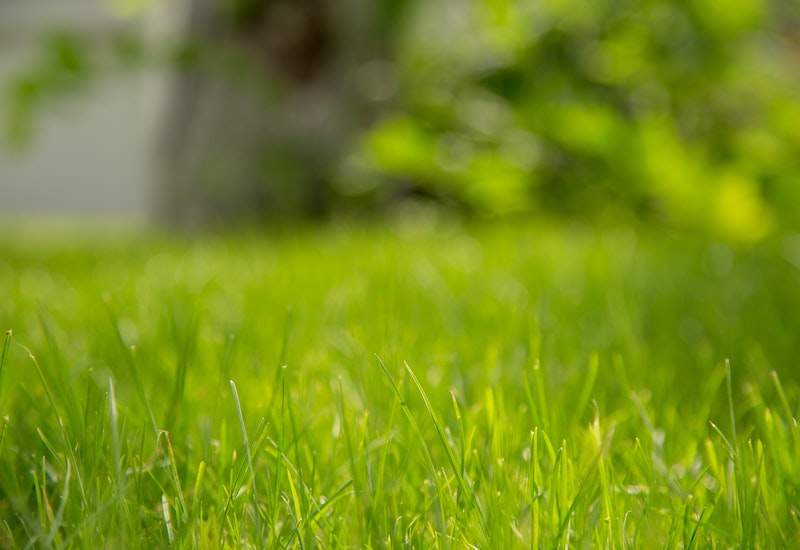
Photo Credit: Pexels
With such a tropical name, it’s no wonder bermudagrass does well in warm climates. This dark to blue-green grass is water-efficient, though it may turn brown during extended drought. It also doesn’t grow well in the shade. It has no significant pest problems and tolerates salinity and foot traffic well.
Bermudagrass can be high or low-maintenance, depending on the variety. While most types have a moderate nitrogen requirement, hybrid varieties require more fertilizer. Most varieties require frequent mowing due to their rapid growth, which provides good resilience during the growing season. However, it could invade garden beds or neighboring yards because of this aggressive growth.
Classification: Warm-season grass
Spreads by: Stolons and rhizomes
Shade tolerance: Poor — needs full sun
Drought tolerance: High
Foot traffic tolerance: High
Maintenance needs: Needs frequent mowing due to fast growth rate; develops thatch easily; needs regular fertilization
Recommended mowing height: 1-2 inches
Potential for disease: Good resistance to disease, although diseases like spring dead spot are common; low resistance to insects like bermudagrass mites, dichondra flea beetles, and fiery skippers
Soil pH: 6-6.5
Soil type: Tolerates most soil types
Other notes: Bermuda spreads aggressively via its stolons (above-ground stems) and rhizomes (below-ground stems) and can out-compete many weeds. The downside is that it also can be a nuisance and is sometimes considered invasive. You’ll often find it has tunneled underground into flower beds and spread into neighboring lawns.
2. Kikuyugrass
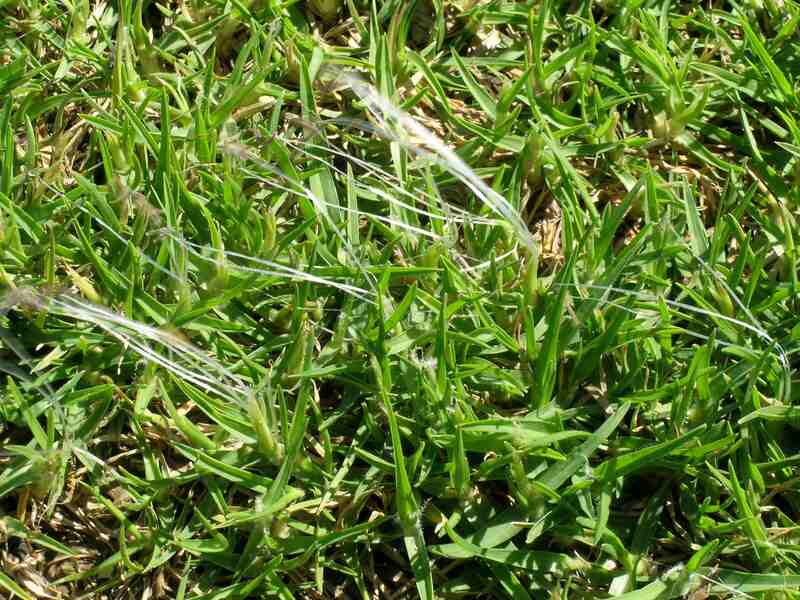
Photo Credit: Harry Rose, Macleay Grass Man / Wikimedia Commons / CC BY-SA 2.0
While some consider this grass a weed, others have adopted it as a turfgrass. Kikuyugrass is light green and coarse-textured with a similar appearance to St. Augustinegrass. It is mainly found within 50 miles of the coast in Southern and Central California but also can survive inland. It has a high temperature, drought, and salinity tolerance. While it tolerates shade, it is susceptible to cold weather.
Kikuyugrass’ quick-spreading growth pattern is a double-edged sword — it recovers from damage well, but it’s also susceptible to thatch and spreads where it’s not wanted. Though the excess thatch makes mowing challenging, that shouldn’t deter you from a regular schedule. If you let it grow too long and cut too much off at once, this turf is likely to suffer for it.
Classification: Warm-season grass
Spreads by: Rhizomes and stolons
Shade tolerance: Moderate
Drought tolerance: High
Foot traffic tolerance: High
Maintenance needs: Low
Recommended mowing height: 1-1.5; it’s vulnerable to scalping damage if it isn’t mowed frequently
Potential for disease: Low
Soil pH: 5.5-7
Soil type: Fertile, moderately drained soils with a light to medium texture; can tolerate low fertility
Other notes: This grass type is native to East Africa and was imported to California to help with erosion. Its aggressive growth makes it more resilient but makes many consider it a weed. It develops thatch easily.
3. St. Augustinegrass
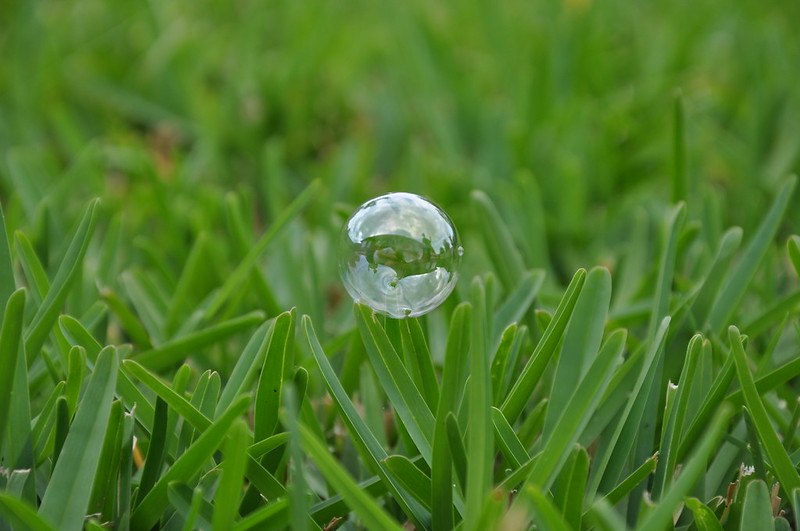
Photo Credit: Jay Morgan / Flickr / CC BY-ND 2.0
This medium green grass creates dense lawns with a high drought and heat tolerance. It does well on the Southern California coast and the coastal valleys. Though St. Augustinegrass has a high shade tolerance for warm-season grass, it prefers full sun. It may go dormant in winter because of its low cold tolerance, but it depends on what part of Southern California you live in.
St. Augustinegrass requires moderate to high maintenance. Though it has few weed problems, it needs lots of fertilization. You also must dethatch regularly to improve grass health and make mowing easier. This grass isn’t the best choice for backyard sports enthusiasts, but it holds up well enough for general lawns. St. Augustinegrass seeds are not commercially available, so you need to establish the grass with sod or stolons.
Classification: Warm-season grass
Spreads by: Stolons
Shade tolerance: Moderate shade tolerance, among the highest of any warm-season grass; some cultivars are more shade tolerant than others
Drought tolerance: Moderate
Foot traffic tolerance: Moderate
Maintenance needs: Moderate to high mowing frequency
Recommended mowing height: 2.5-4 inches (mow dwarf varieties from 2.5-3 inches; standard cultivars from 3-4 inches; mow tall in shade)
Potential for disease: Moderate to high; watch out for iron deficiency, fiery skippers, and Southern chinch bugs
Soil pH: 6-7.5
Soil type: Tolerates many soil types; prefers moderately fertile and moist (not waterlogged) soils; not a highly drought-tolerant grass; doesn’t tolerate soil compaction
Other notes: Native to coastal areas across the world and prefers moist soils and mild winters; will thrive in more inland areas provided growing conditions are met; good salt tolerance; will go dormant during winter in all but the southernmost regions
4. Zoysiagrass
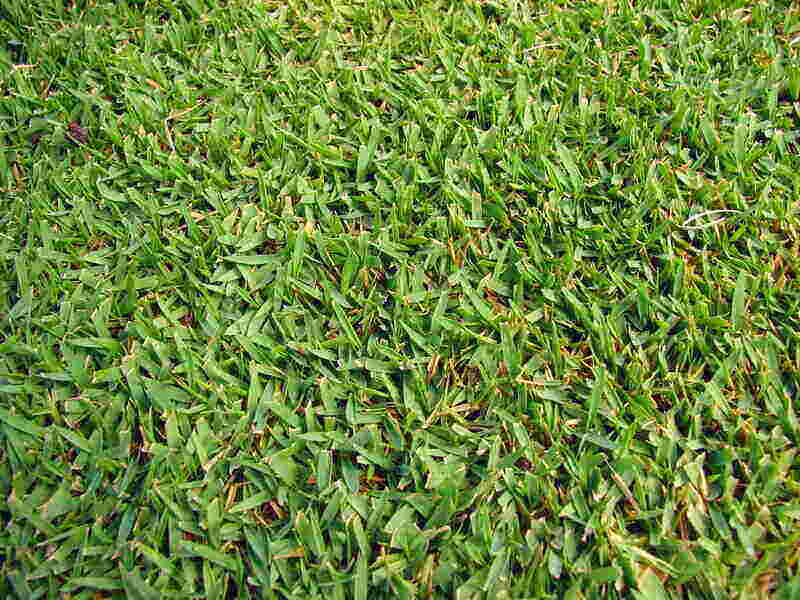
Photo Credit: Forest & Kim Starr / Wikimedia Commons / CC BY 3.0
Zoysiagrass is a dark green grass type that forms thick, prickly turf. It is well adapted to warm climates and has a good drought, heat, and traffic tolerance. This grass does best in full sun but tolerates shade. It can turn brown and dormant in winter if temperatures are cool enough, but fall fertilization can improve its winter color.
Zoysiagrass is generally low-maintenance, with few pest problems and low fertilizer needs. Overfertilization could lead to excessive thatch buildup and difficulty mowing. The biggest downside of Zoysiagrass is its slow establishment. Some varieties like “Emerald”and “DeAnza” establish quicker, but most homeowners install sod or sprigs instead to speed things up.
Classification: Warm-season grass
Spreads by: Stolons and rhizomes
Shade tolerance: Tolerates light to moderate shade
Drought tolerance: High
Foot traffic tolerance: High
Maintenance needs: Low to moderate nitrogen requirement; moderate mowing frequency
Recommended mowing height: 1-2.5 inches
Potential for disease: Not prone to disease and insects; good disease tolerance overall; watch out for nematodes
Soil pH: 6-6.5
Soil type: Well-draining; some cultivars more tolerant of a wide range of soils than others
Other notes: Moderately salt tolerant; cut with sharp mower blade; mow taller if the grass is in partial shade
5. Kentucky Bluegrass
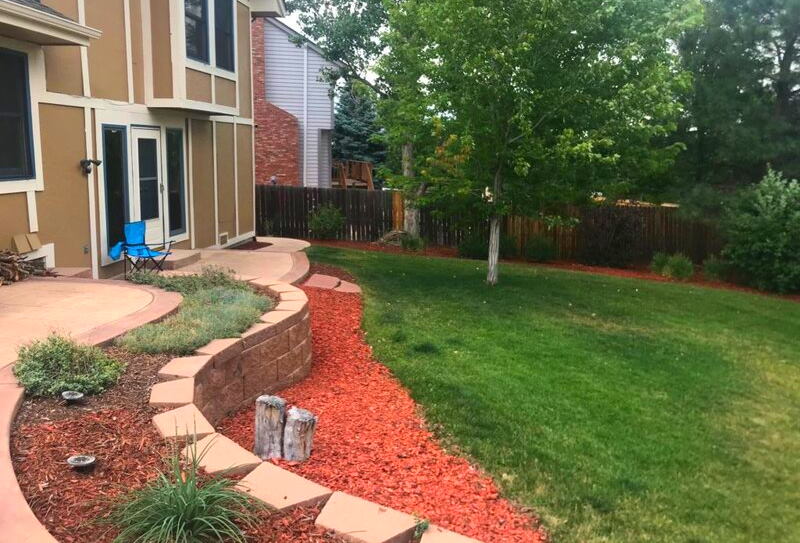
Photo Credit: Brenda Ryan / Wikilawn
Despite the name, this grass type is more dark green than blue. It creates dense turf that repairs itself when damaged. Despite this quick recovery time, it isn’t very traffic tolerant. This moderate to high-maintenance grass prefers full sun but tolerates light shade.
Kentucky bluegrass will grow in Southern California in fall, winter, and spring in Southern California. However, it’s not a good choice if you want a summer superstar. It won’t grow in the heat and will likely go dormant in droughts. When stressed by heat, lack of water, or poor soil quality, it will be much more susceptible to diseases and weeds. Kentucky bluegrass is often mixed with 15% perennial ryegrass, so it performs better.
Classification: Cool-season grass
Spreads by: Rhizomes
Shade tolerance: Low to moderate — prefers full sun
Drought tolerance: Moderate, but will survive by going dormant
Foot traffic tolerance: Low to moderate, but recuperates well
Maintenance needs: Moderate mowing frequency; a high-maintenance grass
Recommended mowing height: 2-3 inches
Potential for disease: Moderate to high
Soil pH: 6-7
Soil type: Good drainage, fertile
Other notes: Produces a dense lawn under ideal conditions; many of these traits (shade tolerance, drought resistance, etc.) vary widely by cultivar, with newer cultivars generally being hardier, more resistant to disease, etc.; mow taller in summer; most often mixed with other species, such as tall fescue, in home lawns
6. Tall Fescue
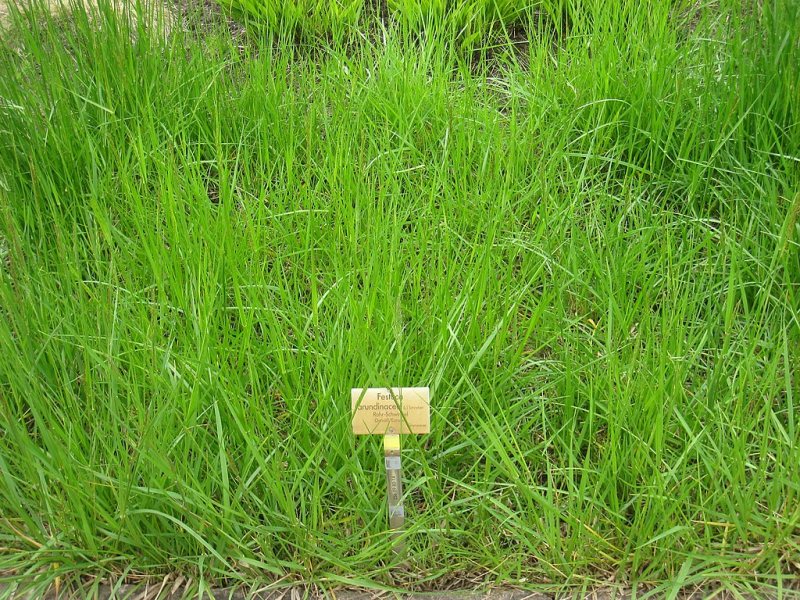
Photo Credit: Daderot / Wikimedia Commons / Public domain
The mild California winters are just right for this cool-season grass. While it does best in fall through spring, it will tolerate warm temperatures and heat stress. Its extensive root system gives it good drought tolerance compared to other cool-season grasses. Tall fescue is low maintenance, with little mowing required. It also has good weed and disease resistance.
This medium to dark green grass is prevalent throughout the state but won’t do well in high-altitude areas. Though tall fescue has moderate traffic tolerance, it may struggle to recover from damage. Reseed any patchy areas since they won’t fill in naturally.
Classification: Cool-season grass
Spreads by: Bunch-type grass
Shade tolerance: Moderate
Drought tolerance: Moderate
Foot traffic tolerance: Moderate, but low ability to recuperate from wear
Maintenance needs: Fast rate of growth, so plan to mow often
Recommended mowing height: 2-4 inches (Check your cultivar and state recommendations. Many tall fescue lawns grow best when they’re mowed on the tall side); do not mow less than 1.5 inches
Potential for disease: Low to moderate under proper management conditions
Soil pH: 5.5-6.5
Soil type: Fertile, good drainage, but will tolerate a wider range of soil conditions
Other notes: Reseed every few years to repair bare spots and thinning; don’t plant old varieties such as Kentucky-31; look for “turf-type” tall fescue (TTTF). Seed blends with more than one TTTF cultivar give the best chance for a strong lawn.
FAQ About Southern California Grass Types
Southern California’s most drought-resistant grass types are bermudagrass, kikuyugrass, and Zoysiagrass. If you would prefer cool-season grass, choose tall fescue.
Bermudagrass, kikuyugrass, and Zoysiagrass are the best grass types for dog owners. They can handle the extra foot traffic and recover from damage. Keep in mind that no grass is completely dog-resistant.
Bermudagrass, Kentucky bluegrass, and tall fescue are available in seed form. They are all suitable for seeding new or existing lawns.
While Zoysiagrass seeds exist, their slow establishment rate makes sod more practical. St. Augustinegrass and kikuyugrass are not commercially available in seed form.
Yes. Kentucky bluegrass is frequently combined with ryegrass or tall fescue to improve performance. Some blends are specially formulated for the SoCal climate. For example, Marathon grass is a mixture of different tall fescue varieties.
Choosing Grass and Plant Varieties for Your Southern California Landscape
You fight a losing battle when you ignore Mother Nature. If you embrace the California climate, your lawn and garden will thrive. Complement your new lawn and reduce your fire risk with drought-resistant landscaping and plants native to Southern California.
Lawn care and landscaping are sweaty work, especially in sunny SoCal. If you need a hand, Wikilawn’s pros are here to help. We can connect you with landscapers and lawn care companies in Los Angeles, San Diego, Anaheim, and many more Southern California cities.
Main Image Credit: Josh Lee / Wikimedia Commons / CC BY-SA 3.0